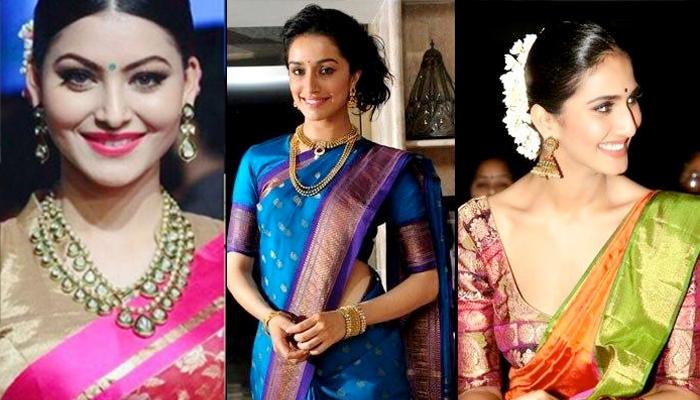


Indian wedding and the sartorial saga that comes along can be overwhelming at times. The intensity of the search to find the right outfit for the bride is the most maddening task.
While lehenga, gararas, sharara have made their ways to almost all the communities and cultures of the country, but saree still holds the fort as one of the top choices for the bridal ensemble.
If you also swear by saree for your bridal look, we suggest you give a serious thought to some of the best variants from South India. Kanjeevaram, Chettinad, Gadwal, Konrad, Mysore Silk and Pochampally Sarees are some of the traditional beauties of this part of the country. For the right guidance, read on!
Recommended Read - Steal The Look: Bollywood Divas In Their South Indian Avatars
While talking about South Indian sarees, let's start with the magnificent Kanjeevaram beauties. It has derived its name from the small temple town called Kanchipuram, around 80 kms from Chennai. Loved for their fabric and gorgeous traditional appeal, Kanchipuram or Kanjeevaram silk is hand woven from mulberry silk thread. The thread is produced by the silkworms that are fed on mulberry leaves.
Also Read: 5 Most Beautiful Traditional Sarees That Every Indian Bride Must Have
The saree gets its identity from pure Zari (a silver thread electro-plated with gold) embroidery and patterns of culture and flora or fauna. Peacocks, horses, parrots, elephants etc. are some of the patterns that adorn the heavy gold-brocaded pallus and borders. Tribal motifs as well as traditional themes drawing inspiration from the Pallava temples and palaces, scenes from epics like Ramayana and the Mahabharata etc are also weaved on the saree, giving it a timeless, ethnic look.
Named after a small town in southern Tamil Nadu, Chettinad saree can be another stunning option for your bridal outfit. The expert weavers craft these sarees with traditional designs. The fabric is basically cotton, but these days even silk is incorporated. The use of silk and cotton threads create a fresh appeal in these sarees gives it a contemporary look, yet retaining the traditional charm. It is famed for creating a visual illusion as it uses plethora of colours and designs.
Read: Top 10 Saree Looks Of Vidya Balan That Will Leave You Impressed
The use of bold horizontal and vertical lines and even checks in complementary vivid hues make it an elegant and vibrant piece. Adding to its beauty is its broad border in contrasting tint. It is also called as Kandaangi saree. The traditional ones are usually available in hues like mustard, brick red and black. So, if your wedding has a lot of morning rituals outdoors, Chettinad saree can be a graceful bet.
A specialty from Tamil Nadu, the Konrad or the temple saree is known for its wide borders and stunning motifs. The weavers add the wedding appeal by designing them with motifs like peacocks, elephants denoting water, fertility and fecundity. The colour options range from earthen hues of browns, greys and off-white colours to vibrant shades. With a distinct identity of its own the Konrad saree has secured a strong place in bridal ensembles.
A perfect fusion of silk, bright hues and rich and traditional appeal makes Mysore sarees a favourite in the 6 yards arena. Usually, a Mysore silk saree weighs between 400 and 600 gms and the price depends on its weight. The silk dyed in natural pigments is woven into intricate yet refined patterns of motifs like birds and fruits. This beautiful creation is experiencing a makeover with inclusion of Kasuti embroidery.
Read: 11 Different Types Of Gorgeous Silk Sarees Every Bride Must Have In Her Wardrobe
This type of embroidery flaunts an array of intricate designs such as chariot, lamps and conch shells. Even the designs are witnessing a fusion of contemporary appeal with a blend of patterns inspired by conventional Indian architecture and ancient Indian ornaments. In recent times, one can observe combination of various designs including floral and abstract ones which are added to the body and pallu through silk-screen printing.
Also known as Pochampalli Ikat, it is a proud produce of Bhoodan Pochampally, Nalgonda district in Telangana. This saree’s fame derives from its traditional geometric shapes in Ikat style of dyeing. A typical traditional Pochampally saree flaunts motifs of parrot, elephant and diamond and flower etc. The fabric ranges from cotton, silk as well as sico - a mix of silk and cotton.
Produced in a small town called Gadwal in Mahbubnagar District, Andhra Pradesh, Gadwal Sarees are famed for their spectacular blend of fabric and designs. The fabric is either silk or cotton, or a hybrid of the two. Often the whole drape of the saree is made with cotton and it dons a silk border ideally composed of Mulberry or Tussar silk. Usually, the body is woven in small checks.
Also Read: South Indian Bridal Inspiration From Alia Bhatt In 2 States
These sarees are woven in interlocked-weft technique which is called Kupadam. Thus, locally it is also known as Kupadam saree. Usually this saree is famed for its array of designs and borders. This striking blend of silk and cotton has produced the trend of Sico sarees. Although, there are pure silk variants too, but they haven’t earned such popularity as Sico has. Representing the cultural patterns of South India are the brocaded designs aesthetically woven in these sarees. Among many designs, the most preferred motifs are of Murugan and Rudraksha.
Recommended Read: Bridal Make-Up Guide For South Indian Brides
While dressing up in a South Indian saree, we advise you to highlight your eye makeup with lavish use of kohl, eye-liner and mascara. A hint of your saree colour through the eyeshadow shade will enhance your look. A traditional hairstyle would complete your look.